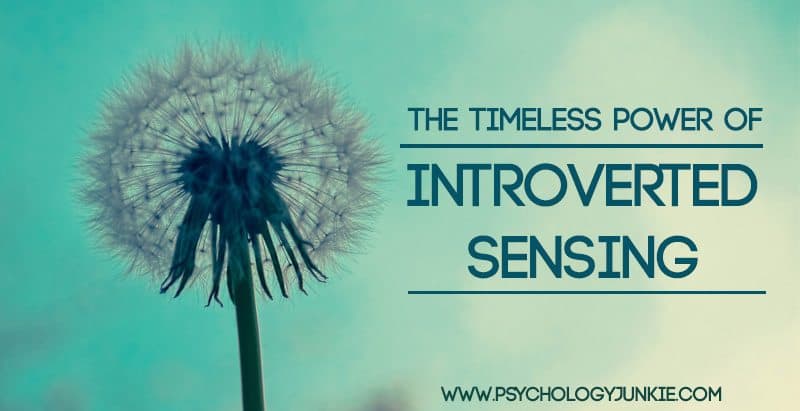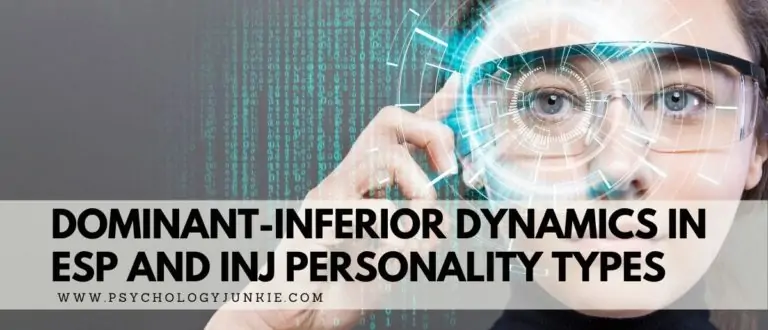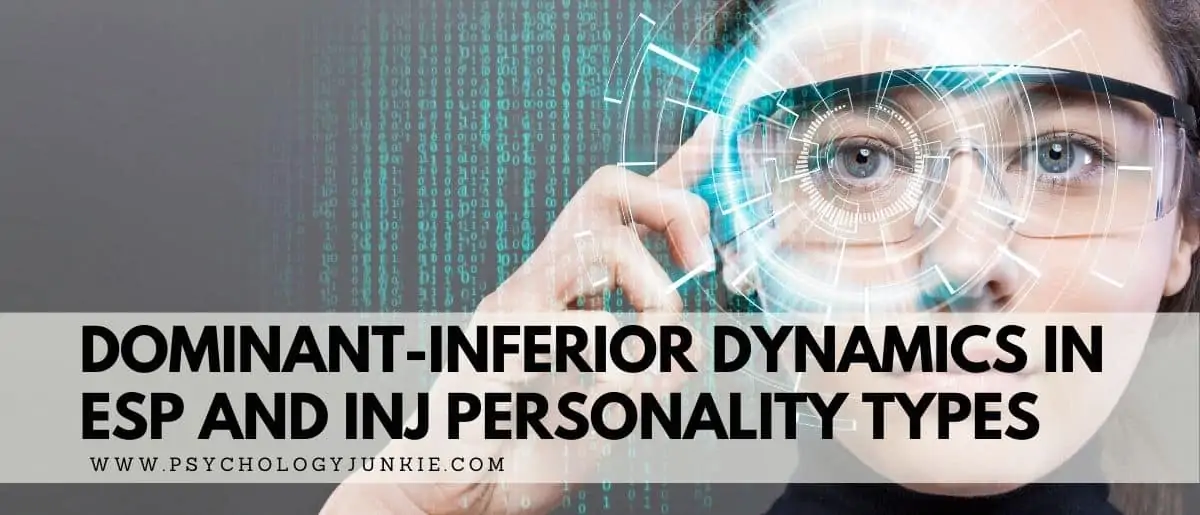The Timeless Power of Introverted Sensing
There are a lot of misconceptions about cognitive functions, particularly with respect to introverted sensing (Si). I’ve heard people refer to SJ types as “conformists” or “slaves to tradition” and other condescending terms. Certain websites will say that Si-users cannot think outside the box or innovate or that they are not creative or intellectual. I just want to say right now that all of that is completely false. The purpose of this article is to really get to the core of what Introverted Sensing truly is and cast aside misrepresentations and misconceptions that have been spreading through the internet.
Table of contents
Estimated reading time: 10 minutes

Let’s start by defining what sensing is
Sensing literally means “sense impression”. It is focused on concrete, physical, tangible reality. For this reason, sensors tend to have a practical, down-to-earth nature. Instead of focusing on the unknown or theoretical, the sensor prefers to focus on what “is.” This doesn’t mean they never want to change what is. Joanna Gaines, an ESFJ, looks at a beat-up house and can imagine how it can be improved and perfected.
Being a Sensing-Judging type doesn’t mean someone can’t read between the lines, use abstract mathematical reasoning, or innovate.
Contrasting Introverted and Extraverted Sensing:

Extraverted sensing is focused on the objective reality of a stimulus or object. When a Se-user (SP type) sees an object or gets a sensation from the outer world he notices every detail and nuance exactly as it is and reacts to it in real-time. He is the ultimate realist. He doesn’t “read into” the object or form a bunch of personal associations with it most of the time. “A car, is a car, is a car” to the extraverted sensor.
Introverted sensing is focused on the subjective impression the stimulus or object gives. When a Si-user sees an object or gets a sensation from the outer world, he absorbs an impression of it, a subjective recollection, memory, or symbol of the object. Carl Jung said of Si that it is “guided by the intensity of the subjective sensation excited by the objective stimulus, but one that is apparently quite unpredictable and arbitrary. What will make an impression and what will not can never be seen in advance, and from the outside.”
If you’re like me, you might need to read that sentence a few times before it’s really easy to understand. To help, here’s an example of how Se and Si might play out differently for its users.

In the book Dynamics of Personality Type, the authors say “If you were to look out your window and see an apple tree and immediately recall an image of an apple tree you’ve seen before and you were then aware of the feel of autumn in the air (even if it is late summer) and remember being in an apple orchard picking apples, you would be engaging in a process of introverted sensing.”
The same book describes the reaction of the extraverted sensor to the apple tree. “You might look out the window and notice the apple tree in your backyard-the contrast of the ruby red apples and the deep green leaves, the rich brown-gray of the trunk and branches, and how the sunlight plays across the yard. You go out the door, reach out, pick an apple, and bite into it with a crunch, savoring the tree-ripened sweetness and the aroma of a really fresh apple….You are one with the experience…The whole scene comes into your awareness almost at once.”
This book gives two brilliant comparisons between introverted and extraverted sensing. If you tend to (but not always) follow the first example then you’re most likely a Si-user. If you tend to (but not always) follow the second example then you’re most likely a Se-user.
What does this object/place/sight/sound mean to me? What does this remind me of? What timeless, intangible qualities does this instantly bring to mind? This is the reality of the introverted sensor.
Another thing to be aware of is that smell can trigger memories for all individuals. This is related to brain anatomy and the fact that smells are processed in brain regions that trigger emotions and memories. However, where the Si-user will instantly be transported to the subjective association related to the object or stimulus and use that to influence his decisions, the Se-user will quickly focus on the objective reality of the object and use its current reality to influence decisions.
Introverted Sensing and Future Visions and Planning:

It’s important to note that introverted sensing is not solely tied to past events. It also sees how the object or sensation can be used in the future. As Carl Jung said, “We could say that introverted sensation transmits an image which does not so much reproduce the object as spread over it the patina of age-old subjective experience and the shimmer of events still unborn. The bare sense impression develops in-depth, reaching into the past and future, while extraverted sensation seizes on the momentary existence of things open to the light of day.”
According to neuroscientist Dario Nardi, introverted sensing types show increased brain activity in regions that plan for the future. They enjoy seeing how something can be used in the future, or how an experience can be created. They may enjoy creating traditions that have sentimental value, like going through an advent calendar every Christmas or eating the same breakfast every Sunday morning. Basically, Si-users experience life in a timeless way. They are constantly shifting through past, present, and future impressions. The present experience will be a memory one day. The current experience reminds us of a similar experience in the past. This same experience can be re-created and enjoyed in the future.
Introverted sensors are quick to pick up on patterns in either systems or human behavior. They think about how situations played out in the past and consider how those same patterns might repeat themselves in the future. They compare and contrast present realities to past experiences to see if patterns are continuing or if there is a noticeable shift or difference.
Related: How You Use Your Brain Based on Your Myers-Briggs® Personality Type
Unhealthy Introverted Sensing:
Extreme or unhealthy introverted sensing can lead to an inability to let go of objects that are tied to particular impressions. As a result, unhealthy Si-users can have issues with hoarding. Instead of seeing a coffee cup that belonged to one’s grandmother, the introverted sensor sees the impression of the grandmother; all the fond memories, the lazy Saturday mornings gathered around the table, the perfume grandmother used to wear, how her voice sounded, her kindness. As a result, the introverted sensor is unable to let go of the coffee mug because it has lost its objective reality, it has, in a way, become a grandmother.
“Above all, his development alienates him from the reality of the object, leaving him at the mercy of his subjective perceptions, which orient his consciousness to an archaic reality…Actually he lives in a mythological world, where men, animals, locomotives, houses, rivers, and mountains appear either as benevolent deities or as malevolent demons.”
– Carl Jung, Psychological Types
Extreme extraverted sensing can lead to an over-indulgence in experience and sensory gratification. The unhealthy Se-user wants new and novel experiences, tastes, feelings, thrills to an excessive or destructive degree.
Examples of Healthy Introverted Sensing:

Healthy introverted sensing looks to stored impressions and data to retain an incredibly accurate knowledge base. SJs can recall with vivid detail exactly how a situation played out before or the important details of systems or people. They swiftly recall facts and details that will be important in the future. When they learn something new that they deem as important they are quick to see how it will benefit them in the future. They may enjoy collecting facts and impressions throughout their life in an effort to use them productively in some way. Lessons learned through personal exposure and observation are rarely lost.
Is Introverted Sensing “Conformist”, or “Overly Traditional”?
There is really nothing about introverted sensing that is conformist. At least not if you trust what Carl Jung wrote about the function. People have made strange leaps of judgment about introverted sensing types; that they are unable to think for themselves or innovate. While it’s true that intuition is more focused on theoretical possibilities and abstract innovation, introverted sensing can be innovative in a hands-on, way. ISTJs like Jeff Bezos and Peter Thiel innovated when they created Amazon and Paypal. There are even SJ philosophers like Thomas Hobbes and Martin Heidegger.

Rosa Parks, an ISFJ, was hardly “conformist” when she refused to surrender her seat on a bus to a white passenger. Mother Teresa, also an ISFJ, lived a wildly compassionate life as she worked in the slums of Calcutta to tend to the poor and hungry. She lived for years without income, begging for food and supplies, and experienced loneliness, and the temptation to return to the comfort of her convent life. These are just a few examples of introverted sensors who innovated, thought outside the box, and made huge, progressive changes in our world.
What Are Your Thoughts?
Has this post given you a better understanding of introverted sensing? Do you have any thoughts to add? Let me know in the comments!
Find out more about your personality type in our eBooks, Discovering You: Unlocking the Power of Personality Type, The INFJ – Understanding the Mystic, The INFP – Understanding the Dreamer, and The INTJ – Understanding the Strategist. You can also connect with me via Facebook, Instagram, or Twitter!

Sources:
Psychological Types (The Collected Works of C. G. Jung, Vol. 6) (Bollingen Series XX)
Depth Typology: C. G. Jung, Isabel Myers, John Beebe and The Guide Map to Becoming Who We Are
Neuroscience of Personality: Brain Savvy Insights for All Types of People














Being and INFP in love with my fiance’ an ISTJ, this article helped me understand further his sensing world* Thanks for sharing your insight.
My Si is tertiairy. My wife has an auxiliairy Si (estj) and her Mum is an isfj. Strong différences !!!
Great post! French writer
This is by far the most helpful post I have ever read about Si. Thank you so much for a balanced (and Jung-based) explanation.